Asimina triloba
Asimina triloba, the American papaw, pawpaw, paw paw, or paw-paw, among many regional names, is a small deciduous tree native to the eastern United States and Canada, producing a large, yellowish-green to brown fruit.[2][3][4] It belongs to the genus Asimina in the same plant family (the Annonaceae) as the custard-apple, cherimoya, sweetsop, ylang-ylang, and soursop.
| Asimina triloba | |
|---|---|
 | |
| Asimina triloba in fruit | |
| Scientific classification | |
| Kingdom: | Plantae |
| Clade: | Tracheophytes |
| Clade: | Angiosperms |
| Clade: | Magnoliids |
| Order: | Magnoliales |
| Family: | Annonaceae |
| Genus: | Asimina |
| Species: | A. triloba |
| Binomial name | |
| Asimina triloba | |
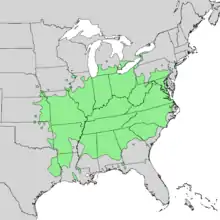 | |
| Natural range of Asimina triloba | |
The pawpaw is a patch-forming (clonal) understory tree found in well-drained, deep, fertile bottomland and hilly upland habitat, with large, simple leaves. Pawpaw fruits are the largest edible fruit indigenous to the United States[5] (not counting gourds, which are typically considered vegetables rather than fruit for culinary purposes, although in botany they are classified as fruit).[6]
Pawpaw fruits have a sweet, custardish flavor somewhat similar to banana, mango, and pineapple, and are commonly eaten raw, but are also used to make ice cream and baked desserts. The bark, leaves, and fruit have been documented as containing the neurotoxin annonacin, which could cause neurodegeneration.[7]
Names
This plant's scientific name is Asimina triloba. The genus name Asimina is adapted from the Native American (probably Miami-Illinois[8]) name assimin or rassimin[9] through the French colonial asiminier.[10] The specific epithet triloba in the species' scientific name refers to the flowers' three-lobed calices and doubly three-lobed corollas,[9] the shape not unlike a tricorne hat.
The common name of this species is variously spelled pawpaw, paw paw, paw-paw, and papaw. It probably derives from the Spanish papaya, an American tropical and subtropical fruit (Carica papaya) sometimes also called "papaw",[11] perhaps because of the superficial similarity of their fruits and the fact that both have very large leaves. The name pawpaw or papaw, first recorded in print in English in 1598, originally meant the giant herb Carica papaya or its fruit (as it still commonly does in many English-speaking communities, including Australia, New Zealand, and South Africa). Daniel F. Austin's Florida Ethnobotany[12] states that:
The original "papaw" ... is Carica papaya. By 1598, English-speaking people in the Caribbean were calling these plants "pawpaws" or "papaws" ... [yet later, when English-speakers settled in] the temperate Americas, they found another tree with a similarly aromatic, sweet fruit. It reminded them of the "papaya", which had already become "papaw", so that is what they called these different plants ... By 1760, the names "papaw" and "pawpaw" were being applied to A. triloba.
Yet A. triloba has had numerous local common names, many of which compare it to a banana rather than to pawpaw or papaya (i.e. to Carica papaya). These include: wild banana, prairie banana, Indiana banana, Hoosier banana, West Virginia banana, Kansas banana, Kentucky banana, Michigan banana, Missouri banana, Appalachian banana, Ozark banana, Indian banana, American custard apple, banango, and the poor man's banana, as well as asimoya,[13] Quaker delight and hillbilly mango.[14]
Several tribes of Native Americans have terms for the pawpaw such as riwahárikstikuc (Pawnee),[15] tózhaⁿ hu (Kansa),[16] and umbi (Choctaw).[17]
Description

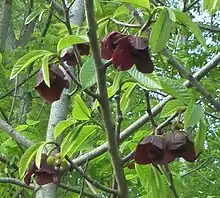
A. triloba is a large shrub or small tree growing to a height of 35 ft (11 m), rarely as tall as 45 ft (14 m), with trunks 8–12 in (20–30 cm) or more in diameter. The large leaves of pawpaw trees are clustered symmetrically at the ends of the branches, giving a distinctive imbricated appearance to the tree's foliage.[9][18]
The leaves of the species are simple, alternate and spirally arranged, entire, deciduous, obovate-lanceolate, 10–12 in (25–30 cm) long, 4–5 in (10–13 cm) broad, and wedge-shaped at the base, with an acute apex and an entire margin, with the midrib and primary veins prominent. The petioles are short and stout, with a prominent adaxial groove. Stipules are lacking. The expanding leaves are conduplicate, green, covered with rusty tomentum beneath, and hairy above; when fully grown they are smooth, dark green above, and paler beneath. When bruised, the leaves have a disagreeable odor similar to a green bell pepper. In autumn, the leaves are a rusty yellow, allowing pawpaw groves to be spotted from a long distance.[6][9][18]
Pawpaw flowers are perfect, about 1–2 in (3–5 cm) across, rich red-purple or maroon when mature, with three sepals and six petals. They are borne singly on stout, hairy, axillary peduncles. The flowers are produced in early spring at the same time as or slightly before the new leaves appear, and have a faint fetid or yeasty smell.[6][9][18][19]

The fruit of the pawpaw is a large, yellowish-green to brown berry, 2–6 in (5–15 cm) long and 1–3 in (3–8 cm) broad, weighing from 0.7–18 oz (20–510 g), containing several brown or black seeds 1⁄2–1 in (15–25 mm) in diameter embedded in the soft, edible fruit pulp. The conspicuous fruits begin developing after the plants flower; they are initially green, maturing by September or October to yellow or brown. When mature, the heavy fruits bend the weak branches down.[6][9][18]
Other characteristics:
- Calyx: Sepals three, valvate in bud, ovate, acuminate, pale green, downy[9][18]
- Corolla: Petals six, in two rows, imbricate in the bud; inner row acute, erect, nectariferous; outer row broadly ovate, reflexed at maturity; petals at first are green, then brown, and finally become dull purple or maroon and conspicuously veiny[9][18]
- Stamens: Indefinite, densely packed on the globular receptacle; filaments short; anthers extrorse, two-celled, opening longitudinally[18]
- Pollen: Shed as permanent tetrads[20]
- Pistils: Several, on the summit of the receptacle, projecting from the mass of stamens; ovary one-celled; stigma sessile; ovules many[18]
- Branchlets: Light brown, tinged with red, marked by shallow grooves[18]
- Winter buds: Small, of two kinds, the leaf buds pointed and closely appressed to the twigs, and the flower buds round, brown, and fuzzy[9]
- Bark: Light gray, sometimes blotched with lighter gray spots, sometimes covered with small excrescences, divided by shallow fissures; inner bark tough, fibrous; bark with a very disagreeable odor when bruised[9][18]
- Wood: Pale, greenish yellow, sapwood lighter; light, soft, coarse-grained and spongy with a specific gravity of 0.3969 and a density of 24.74 pounds per cubic foot (396.3 kg/m3)[9][18]
- Longevity of fruit production: Undetermined[21]
Range and ecology
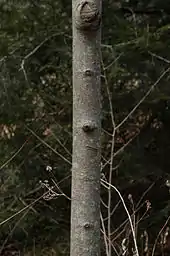
The pawpaw is native to the Eastern, Southern, and Midwestern United States and adjacent Ontario, Canada, from New York west to southeastern Nebraska, and south to northern Florida and eastern Texas.[6][22][23]
The tree commonly grows in floodplains and shady, rich bottomlands, where it often forms a dense, clonally spreading undergrowth in the forest, often appearing as a patch or thicket of individual, small, slender trees. Pawpaws are not the first to colonize a disturbed site (arriving roughly four years after a clearcut), but may become dominant and slow the establishment of oaks and hickories. Although shade-tolerant, pawpaws do not persist in undisturbed old growth forest. Pawpaws spread locally primarily by root suckers; sexual reproduction by seed does also occur, but at a fairly low rate.[24]
Pawpaw flowers are insect-pollinated, but fruit production is sometimes limited as few if any pollinators are attracted to the flower's faint, or sometimes nonexistent scent.[25] The flowers produce an odor similar to that of rotting meat to attract blowflies or carrion beetles for cross-pollination. Other insects that are attracted to pawpaw flowers include scavenging fruit flies, carrion flies, and beetles. Because of irregular fruit production, some believe pawpaw plants are self-incompatible, requiring cross-pollination between trees of different clones (patches).[25]
The fruits of the pawpaw are eaten by a variety of mammals, including raccoons, gray foxes, opossums, squirrels, and black bears.[24]
The disagreeable-smelling leaves, twigs, and bark of pawpaws contain natural insecticides known as acetogenins.[26] Pawpaw leaves and twigs are seldom consumed by rabbits, deer, or goats,[27] or by many insects.[6] However, mules have been seen eating pawpaw leaves in Maryland.[28]
Larvae of the zebra swallowtail (Protographium marcellus), a butterfly, feed exclusively on young leaves of A. triloba and various other pawpaw (Asimina) species, but never occur in great numbers on the plants.[27] Chemicals in the pawpaw leaves confer protection from predation throughout the butterflies' lives, as trace amounts of acetogenins remain present, making them unpalatable to birds and other predators.[29]
Conservation status
On a global (range-wide) scale, the common pawpaw (A. triloba) has a NatureServe global conservation rank of G5 (very common). In the United States, the species has an N5 (very common), but is considered a threatened species in New York, and an endangered species in New Jersey. In Canada, where the species is found only in portions of southern Ontario, it has a rank of N3 (vulnerable), and a NatureServe subnational conservation rank of S3 (vulnerable) in Ontario. The Ontario Ministry of Natural Resources has given the species a general status of "Sensitive", and its populations there are monitored.
In areas in which deer populations are dense, pawpaws appear to be becoming more abundant locally, since the deer avoid them, but consume seedlings of most other woody plants.[28]
History
The natural distribution of the common pawpaw in North America, prior to the ice ages and lasting until roughly 10,000 years ago, was done by certain megafauna until they became extinct during the Quaternary extinction event.[30] After the arrival of humans and the subsequent extinction of megafauna that were distributing A. triloba, the probable distribution of these large fruit-bearing plants has been by humans.[30]
The earliest documented mention of pawpaws is in the 1541 report of the Spanish de Soto expedition, who found Native Americans east of the Mississippi River cultivating what some have identified as the pawpaw.[31] The Lewis and Clark Expedition consumed pawpaws during their travels.[31] Thomas Jefferson planted it at Monticello, his home in Virginia.[31] Legend has it that chilled pawpaw fruit was a favorite dessert of George Washington.[32]
Research
Kentucky State University (KSU) has the only full-time pawpaw research program in the world; it was started in 1990 with the aim of developing pawpaw as a new tree-fruit crop for Kentucky. Pawpaw is the largest native fruit in North America and has very few diseases compared to other orchard crops. KSU is the site of the USDA National Clonal Germplasm Repository for Asimina species and the pawpaw orchards at KSU contain over 1,700 trees. Research activities include germplasm collection and variety trials, and efforts are directed towards improving propagation, understanding fruit ripening and storage, and developing orchard management practices. Cultivation is best in hardiness zones 5-9 and trees take 7-8 years from seedling to fruiting. KYSU has created the three cultivars KSU-'Atwood', KSU-'Benson', and KSU-'Chappell', with foci on better flavors, higher yields, vigorous plants, and low seed-to-pulp ratios.[33][5][34][35][36][37]
Cultivation
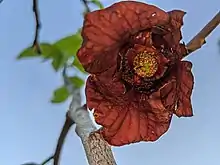
In cultivation, lack of successful pollination is the most common cause of poor fruiting. Cultivation is best in hardiness zones 5-9[5] and trees take 7-8 years from seedling to fruiting. Cross-pollination of at least two different genetic varieties of the plant is recommended,[6] and growers often resort to hand pollination or to use of pollinator attractants such as spraying fish emulsion or hanging chicken necks or other meat near the open flowers to attract pollinators. While pawpaws are larval hosts for the zebra swallowtail butterfly, these caterpillars are usually present only at low density, and not detrimental to the foliage of the trees.[27]
Pawpaws have never been cultivated for their fruits on the scale of apples or peaches, primarily because pawpaw fruits ripen to the point of fermentation soon after they are picked, and only frozen fruit stores or ships well. Other methods of preservation include dehydration, production of jams or jellies, and pressure canning (using the numerical values for bananas).
Cultivation of pawpaws for fruit production has attracted interest, particularly among organic growers, as a fruit with few to no pests that can successfully be grown in its native environment without pesticides. The commercial cultivation and harvesting of pawpaws is strong in southeastern Ohio[38] and also being explored in Kentucky[6] and Maryland,[28] as well as various areas outside the species' native range, including California,[27] the Pacific Northwest,[27] and Massachusetts.[39] The pawpaw is also gaining in popularity among landscapers and backyard gardeners because of the tree's distinctive growth habit, the appeal of its fresh fruit, and its relatively low maintenance needs once established.[19]
Propagation
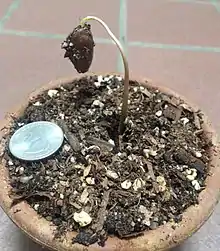
Trees are easily grown from seed. It is easiest to simply plant an entire fruit in the ground or place a seed in the ground immediately upon eating the fruit. Seeds should not be dried out, as they lose viability if they dehydrate to 5% moisture.[40] The seeds need to be stratified by moist cold storage for 60-100 days at 35–45 °F (2–7 °C) (some publications suggest 90-120 days).[40][36][35] They will lose their viability if stored for 3 years or more; some seeds survive if stored for 2 years. Germination is hypogeal and cotyledons remain within the seed coat. Strictly speaking, hypogeal means the cotyledons stay in the soil, acting as a food store for the seedling until the plumule emerges from the soil on the epicotyl or true stem. However, pawpaw seeds have occasionally been observed to emerge from the ground and form the true stem and plumule above ground.
Propagation using cuttings has generally not been successful.[40][36]
Desirable cultivars are propagated by chip budding or whip grafting onto a root stock. Pawpaw seeds do not grow "true to type" — each individual seed in a fruit is genetically different from the others and from its parent tree. Purchased cultivars do not produce seeds true to type, either, which is why cultivars are all grafted trees. Root sucker seedlings, however, are all genetically identical to their host.[36][35]
Commercial nurseries usually ship seedlings in containers, usually grafted cultivars, but other nurseries such as the Kentucky Division of Forestry ship bareroot seedlings for reforestation projects and area homeowners.[41][35]
Harvesting seedlings from the forest floor is tricky because most forest-floor seedlings are actually root suckers with few roots, and those seedlings that did grow from a seed have deep taproots.[36][35]
Blowflies, such as C. vomitoria, are known pollinators of these plants.
Cultivars
Over the years, many cultivars of A. triloba have been developed or discovered.[42] Many have been lost and are no longer available commercially.[31][43][37]
The named varieties producing large fruit and performing well in Kentucky per research trials are 'NC-1', 'Overleese', 'Potomac', 'Shenandoah', 'Sunflower', 'Susquehanna', 'Wabash', KSU-'Atwood', KSU-'Benson', and KSY-'Chappell'.[35]
Habitat restoration
Pawpaws are sometimes included in ecological restoration plantings, since this tree grows well in wet soil and has a strong tendency to form well-rooted colonial thickets.
Uses
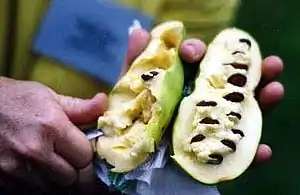
| Nutritional value per 100 g (3.5 oz) | |
|---|---|
18.8 g | |
| Dietary fiber | 2.6 g |
1.2 g | |
1.2 g | |
| Vitamins | Quantity %DV† |
| Vitamin A equiv. | 11% 87 μg |
| Thiamine (B1) | 1% 0.01 mg |
| Riboflavin (B2) | 8% 0.09 mg |
| Niacin (B3) | 7% 1.1 mg |
| Vitamin C | 22% 18.3 mg |
| Minerals | Quantity %DV† |
| Calcium | 6% 63 mg |
| Iron | 54% 7 mg |
| Magnesium | 32% 113 mg |
| Manganese | 124% 2.6 mg |
| Phosphorus | 7% 47 mg |
| Potassium | 7% 345 mg |
| Zinc | 9% 0.9 mg |
| |
| †Percentages are roughly approximated using US recommendations for adults. | |
Fruits
As described by horticulturist Barbara Damrosch, the fruit of the pawpaw "looks a bit like mango, but with pale yellow, custardy, spoonable flesh and black, easy-to-remove seeds."[39] Wild-collected pawpaw fruits, ripe in late August to mid-September, have long been a favorite treat throughout the tree's extensive native range in eastern North America, and on occasion are sold locally at farmers' markets.[6][39] Pawpaw fruits have a sweet, custard-like flavor somewhat similar to banana, mango, and cantaloupe,[6][9] varying significantly by source or cultivar,[6] with more protein than most fruits.[6] Nineteenth-century American agronomist E. Lewis Sturtevant described pawpaws as
... a natural custard, too luscious for the relish of most people[28]
Ohio botanist William B. Werthner noted that
The fruit ... has a tangy wild-wood flavor peculiarly its own. It is sweet, yet rather cloying to the taste and a wee bit puckery.[9]
Fresh fruits of the pawpaw are commonly eaten raw, either chilled or at room temperature. However, they can be kept only 2–3 days at room temperature, or about a week if refrigerated.[19] The easily bruised pawpaw fruits do not ship well unless frozen.[6][39] Where pawpaws grow, the fruit pulp is also often used locally in baked dessert recipes, with pawpaw often substituted with volumetric equivalency in many banana-based recipes. Pawpaws may also be blended into ice cream[19] or included in pancakes.[19]
Nutrition
According to a report from the KSU Pawpaw Program (right table), raw pawpaw (with skin) is 19% carbohydrates, 1% protein, 1% fat, and 79% water (estimated). In a 100-g reference amount, the raw fruit provides 80 Calories and is a rich source (20% or more of the Daily Value, DV) of vitamin C (22% DV), magnesium (32% DV), iron (54% DV), and manganese (124% DV). The fruit also contains a moderate amount of vitamin A (11% DV).
Phytochemicals
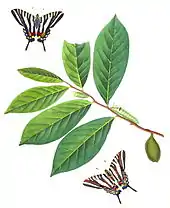
Phytochemical extracts of the leaves and fruit contain acetogenins, including the neurotoxin annonacin.[44] The seeds and bark contain the chemical asimitrin[45] and other acetogenins, including asimin, asiminacin and asiminecin.[44][46]
Effect on insects
Due to the presence of acetogenins, the leaves, twigs, and bark of pawpaw trees can be used to make an organic insecticide.[26] The one notable exception is the zebra swallowtail butterfly (Eurytides marcellus), whose larvae feed on the leaves of various species of Asimina, conferring protection from predation throughout the butterflies' lives, as trace amounts of acetogenins remain present, making them unpalatable to birds and other predators.[29]
Historical uses
The tough, fibrous inner bark of the pawpaw was used by Native Americans and settlers in the Midwest for making ropes, fishing nets, and mats,[9][28] and for stringing fish.[10]
Pawpaw logs have been used for split-rail fences in Arkansas.[9]
The hard, brown, shiny lima-bean-sized seeds were sometimes carried as pocket pieces in Ohio.[9]
Cultural significance
Old song
A traditional American folk song portrays wild harvesting of pawpaws; Arty Schronce of the Georgia Department of Agriculture gives these lyrics:[19]
Where, oh where is dear little Nellie?
Where, oh where is dear little Nellie?
Where, oh where is dear little Nellie?
Way down yonder in the pawpaw patch
Pickin' up pawpaws, puttin' 'em in your pocket
Pickin' up pawpaws, puttin' 'em in your pocket
Pickin' up pawpaws, puttin' 'em in your pocket
Way down yonder in the pawpaw patch
He notes that "picking up pawpaws" refers to gathering the ripe, fallen fruit from beneath the trees, and that the "pocket" in the song is that of an apron or similar tie-on pocket, not a modern pants or blue-jeans pocket, into which pawpaws would hardly fit.[19] A "pawpaw patch" refers to the plant's characteristic patch-forming clonal growth habit.
Place names
The pawpaw is the basis for various place and school names in the United States, almost all using the older spelling variant "paw paw".
- The Paw Paw Tunnel in Maryland is a 3118-foot (950-m) canal tunnel completed in 1850 to bypass about 5 miles of the 6-mile-long Paw Paw Bends of the Potomac River near the town of Paw Paw, West Virginia, all ultimately named after the pawpaw tree.[47]
- In Michigan, the Paw Paw River is named for the pawpaw trees that grew along its banks. Paw Paw Lake and Little Paw Paw Lake are both tributaries to the river. The town of Paw Paw, Michigan, is located at the junction of two branches of the Paw Paw River. The Paw Paw Railroad (1857–1887) operated a 4-mile (6.4-km) rail line between Lawton and Paw Paw, in Van Buren County, Michigan.[48]
- The village of Paw Paw, Illinois, was named after a nearby grove of pawpaw trees.[49]
- The community of Paw Paw, Indiana, in Miami County, and Paw Paw Township in DeKalb County and Paw Paw Township in Wabash County are all named after groves of native pawpaw trees.[50]
- Paw Paw, Kentucky, a community in easternmost Kentucky, was named after the native fruit tree.[51]
- The (now extinct) town of Paw Paw, Missouri, was named after the trees.[52]
Art
.jpg.webp)
- Nineteenth-century naturalist and painter John James Audubon included pawpaw foliage and fruits in the background of his illustration of the yellow-billed cuckoo (Coccyzus americanus) in his classic work, The Birds of America (1827–1838).
- Pawpaw fruits and a pawpaw leaf are featured in the painting Still Life with Pawpaws (circa 1870–1875) by Edward Edmondson, Jr. (1830–1884), at the Dayton Art Institute in Dayton, Ohio.
Other
- The third Thursday in September has been designated as National Pawpaw Day by the National Day Calendar.[53] It was announced on September 19, 2019,[54] at Kentucky State University's monthly sustainable agriculture workshop, the Third Thursday Thing.[55]
- The pawpaw was designated as Ohio's state native fruit in 2009.[56]
- Since 1999, the Ohio Pawpaw Growers' Association has sponsored an annual Ohio Pawpaw Festival at Lake Snowden, near Albany, Ohio.[57]
- Since 2012, Delaware's Alapocas Run State Park has hosted an annual Pawpaw Folk Festival featuring tastings of the fruit.[58]
- The larva of the Pawpaw sphinx moth feeds on pawpaw fruit.
References
- Botanic Gardens Conservation International (BGCI) & IUCN SSC Global Tree Specialist Group (2018). "Asimina triloba". The IUCN Red List of Threatened Species. IUCN. 208. e.T135958357A135958359. doi:10.2305/IUCN.UK.2018-2.RLTS.T135958357A135958359.en.
- Kirk W. Pomper (2019). "Pawpaw: Frequently Asked Questions". Kentucky State University, Cooperative Extension Program. Archived from the original on 30 December 2019. Retrieved 30 December 2019.
- "Asimina triloba". College of Agriculture and Life Sciences, North Carolina State University. Archived from the original on 2018-04-06. Retrieved 2018-12-19.
- Layne DR (1998-02-24). "Pawpaw". NewCrop Factsheet, Purdue University. Archived from the original on 2019-07-11. Retrieved 2018-12-19.
- Pomper, Kirk W.; Layne, Desmond R.; Peterson, R. Neal (1999). "The Pawpaw Regional Variety Trial". hort.purdue.edu. Archived from the original on 2015-04-14. Retrieved 2019-09-26.
- Jones, Snake C.; Layne, Desmond R. (2019). "Pawpaw Description and Nutritional Information". Kentucky State University, Cooperative Extension Program. Archived from the original on 30 December 2019. Retrieved 30 December 2019.
- Avalos, J; Rupprecht, J. K.; McLaughlin, J. L.; Rodriguez, E (1993). "Guinea pig maximization test of the bark extract from pawpaw, Asimina triloba (Annonaceae)". Contact Dermatitis. 29 (1): 33–5. doi:10.1111/j.1600-0536.1993.tb04533.x. PMID 8365150. S2CID 41590523.
- Chamberlain, Alexander F. (1 December 1902). "Algonkian Words in American English: A Study in the Contact of the White Man and the Indian". The Journal of American Folklore. American Folklore Society. 15 (59): 240–267. doi:10.2307/533199. ISSN 0021-8715. JSTOR 533199.
- Werthner, William B. (1935). Some American Trees: An intimate study of native Ohio trees. New York: The Macmillan Company. pp. xviii + 398 pp.
- Sargent, Charles Sprague (1933). Manual of the trees of North America (exclusive of Mexico). Boston and New York: Houghton Mifflin Company: The Riverside Press Cambridge. pp. xxvi + 910.
- Harper, Douglas. "papaya". Online Etymology Dictionary. Retrieved 2012-10-28.
- CRC Press, 2004, p.122.
- "The Asimoya". The Archives of the Rare Fruit Council of Australia. 1 November 1996. Archived from the original on 29 March 2018. Retrieved 26 November 2017.
- "This Once-Obscure Fruit Is On Its Way To Becoming PawPaw-Pawpular". NPR. Archived from the original on 5 April 2018. Retrieved 4 April 2018.
- "American Indian Studies Research Institute". zia.aisri.indiana.edu. Archived from the original on 2018-12-13. Retrieved 2018-12-18.
- "English to Kanza Dictionary" (PDF). kawnation.com. Archived (PDF) from the original on 2016-10-11. Retrieved 2018-12-18.
- Byington, Cyrus (1915). A dictionary of the Choctaw language. Washington D.C.: United States Government Printing office. pp. 359. ISBN 1566321085. OCLC 53387982. Archived from the original on 2017-07-28. Retrieved 2018-12-18.
- Keeler, Harriet L. (1900). Our Native Trees and How to Identify Them. New York: Charles Scribner's Sons. pp. 20–23. Archived from the original on 2019-12-18. Retrieved 2019-11-07.
- Krewer, Gerard W.; Crocker, Thomas F.; Bertrand, Paul F.; Horton, Dan L. (February 2015) [2012]. "Minor Fruits and Nuts in Georgia - Pawpaw, Bulletin 992". University of Georgia Cooperative Extension, College of Agricultural & Environmental Sciences, Athens, GA. Archived from the original on 20 October 2016. Retrieved 19 October 2016.
- Walker JW (1971) Pollen Morphology, Phytogeography, and Phylogeny of the Annonaceae. Contributions from the Gray Herbarium of Harvard University, 202: 1-130.
- Cantaluppi, C. J. (2016-06-01). "The Pawpaw: An Emerging Specialty Crop". Journal of the NACAA. 9 (1). ISSN 2158-9429. Archived from the original on 2018-12-19. Retrieved 2018-12-19.
- Robert Kral (1997). "Annonaceae". In Flora of North America Editorial Committee (ed.). Magnoliophyta: Magnoliidae and Hamamelidae. Flora of North America. 3. New York, NY: Oxford University Press. ISBN 978-0-19-511246-7.
- "Asimina triloba (L.) Dunal". Plants Database, Natural Resources Conservation Service, US Department of Agriculture. 2017. Archived from the original on 27 April 2017. Retrieved 23 May 2017.
- Asimina triloba Archived 2011-06-28 at the Wayback Machine, Fire Effects Information System, U.S. Department of Agriculture, Forest Service, Rocky Mountain Research Station, Fire Sciences Laboratory
- "Asimina triloba - pawpaw". Apios Institute. Archived from the original on 2010-10-24. Retrieved 2014-02-23.
- B. J. Sampson, J. L. McLaughlin, D. E. Wedge. 2003. PawPaw Extract as a Botanical Insecticide, 2002. Arthropod Management Tests, vol.28, p. L.
- "Pawpaw". California Rare Fruit Growers. Archived from the original on 20 July 2011. Retrieved 15 July 2011.
- Bilton, Kathy. "Pawpaws: A paw for you and a paw for me". Archived from the original on 18 July 2011. Retrieved 21 July 2011.
- John M. Martin; Stephen R. Madigosky; Zhe-ming Gu; Dawei Zhou; Jinn Wu; Jerry L. McLaughlin (January 1999). "Chemical defense in the zebra swallowtail butterfly, Eurytides marcellus, involving annonaceous acetogenins". Journal of Natural Products. 62 (1): 2–4. doi:10.1021/np980308s. PMID 9917274.
- Connie Barlow (2001). "Anachronistic Fruits and the Ghosts Who Haunt Them" (PDF). Harvard University Arboretum. Archived (PDF) from the original on 12 February 2013. Retrieved 5 December 2012.
- Andrew Moore (2015). Pawpaw: In Search of America's Forgotten Fruit. White River Junction, Vermont: Chelsea Green Publishing. ISBN 9781603585965. Retrieved November 28, 2020.
- Ahuja, Akshay (September 10, 2015). "Rediscovering The Pawpaw". cincinnatimagazine.com. Archived from the original on October 12, 2016. Retrieved May 29, 2020.
- "USDA National Clonal Germplasm Repository for Asimina spp. at KSU, Slide 4". Kentucky State University. Archived from the original on 2019-09-26. Retrieved 2019-09-26.
- "PawPaw". Kentucky State University. Archived from the original on 2019-09-21. Retrieved 2019-09-22.
- Kaiser, Cheryl; Ernst, Matt (July 2018). "Pawpaw" (PDF). University of Kentucky, College of Agriculture, Food and Environment, Cooperative Extension Service. Archived (PDF) from the original on 2019-07-15. Retrieved 2019-09-22.
- "Chapter: Propagation, The Pawpaw M. Brett Callaway. Originally published as a booklet in 1990 by Kentucky State University, edited and converted to web format in 1998 by Snake C. Jones". pawpaw.kysu.edu. Kentucky State University.
- Pomper, Kirk W.; Crabtree, Sheri B.; Lowe, Jeremiah D. (January 21, 2009). "2009 Pawpaw Cultivars and Grafted Tree Sources". Kentucky State University. Archived from the original on September 22, 2019. Retrieved September 22, 2019.
- "The 15th Annual Ohio Pawpaw Festival". Ohio Pawpaw Festival. Archived from the original on 2013-07-31. Retrieved 2013-08-09.
- Damrosch, Barbara (8 Sep 2011). "Return of the Native? Pawpaws' Proponents". The Washington Post (Local Living, p.9).
- "Propagation of Pawpaw (Asimina triloba)". International Plant Propagators' Society. Combined Proceedings of Annual Meetings. 2000. Retrieved 17 May 2016.
- "State Nurseries and Tree Seedlings - Kentucky Energy and Environment Cabinet". eec.ky.gov. Archived from the original on 2019-09-24. Retrieved 2019-09-22.
- "Sorten der Indianerbanane". Florians Pawpawschule - Asimina triloba (in German). Archived from the original on 2020-06-10. Retrieved 2020-06-10.
- "Table 3. Pawpaw Cultivars". pawpaw.kysu.edu. Kentucky State University.
- Potts, L. F.; Luzzio, F. A.; Smith, S. C.; Hetman, M; Champy, P; Litvan, I (2012). "Annonacin in Asimina triloba fruit: Implication for neurotoxicity" (PDF). NeuroToxicology. 33 (1): 53–8. doi:10.1016/j.neuro.2011.10.009. PMID 22130466. Archived (PDF) from the original on 2016-10-05. Retrieved 2016-08-18.
- Eun Jung Kim; Kyung Mi Suh; Dal Hwan Kim; Eun Joo Jung; Chang Seob Seo; Jong Keun Son; Mi Hee Woo; Jerry L. McLaughlin (February 2005). "Asimitrin and 4-hydroxytrilobin, new bioactive annonaceous acetogenins from the seeds of Asimina triloba possessing a bis-tetrahydrofuran ring". Journal of Natural Products. 68 (2): 194–197. doi:10.1021/np040184l. PMID 15730242.
- Geng-Xian Zhao; Laura R. Miesbauer; David L. Smith; Jerry L. McLaughlin (June 1994). "Asimin, asiminacin, and asiminecin: novel highly cytotoxic asimicin isomers from Asimina triloba". Journal of Medicinal Chemistry. 37 (13): 1971–1976. doi:10.1021/jm00039a009. PMID 8027979.
- "Paw Paw Tunnel". Town of Paw Paw, West Virginia. Archived from the original on October 6, 2011. Retrieved 15 July 2011.
- "RRHX - Railroad History Time Line - 1860". RRHX: Railroad History of Michigan. Archived from the original on 2011-07-23. Retrieved 6 August 2011.
- Zeimetz, Lisa. "Stephen Wright House Archived 2019-09-21 at the Wayback Machine," (PDF), National Register of Historic Places Nomination Form, 1 April 2005, HAARGIS Database, Illinois Historic Preservation Agency. Retrieved September 21, 2019.
- History of Miami County, Indiana: From the Earliest Time to the Present. Brant & Fuller. 1887. pp. 536.
paw-paw.
- Hess, Cameron M. Ludwick & Blair Thomas (30 March 2015). My Old Kentucky Road Trip: Historic Destinations & Natural Wonders. Arcadia Publishing. p. 168. ISBN 978-1-62619-816-6.
- "Sullivan County, Missouri Place Names, 1928-1945 | The State Historical Society of Missouri". collections.shsmo.org. Archived from the original on 2019-09-21. Retrieved 2019-09-21.
- "NATIONAL PAWPAW DAY - Third Thursday in September". National Day Calendar. Archived from the original on 2019-09-21. Retrieved 2019-09-21.
- "Third Thursday Thing Program". kysu.edu. Kentucky State University. Archived from the original on 2019-09-21. Retrieved 2019-09-21.
- "The 'Third Thursday Thing': Eleven Years and Going Strong". kysu.edu. Kentucky State University. Archived from the original on 2019-09-21. Retrieved 2019-09-21.
- Ohio Revised Code 5.082 Archived 2010-09-06 at the Wayback Machine
- "Ohio Pawpaw Festival". ohiopawpawfest.com. Archived from the original on 2020-01-04. Retrieved 2020-05-11.
- "Pawpaw Folk Festival set for Aug. 20 at the Blue Ball Barn". 15 August 2016. Archived from the original on 2 December 2016. Retrieved 9 December 2016.
Further reading
| Library resources about Asimina triloba |
- Moore, Andrew (2015). Pawpaw: In Search of America's Forgotten Fruit. Chelsea Green Publishing. ISBN 978-1603585972.
External links
 Media related to Asimina triloba at Wikimedia Commons
Media related to Asimina triloba at Wikimedia Commons Data related to Asimina triloba at Wikispecies
Data related to Asimina triloba at Wikispecies- Kentucky State University Pawpaw Program
- The Pawpaw: Foraging For America's Forgotten Fruit
